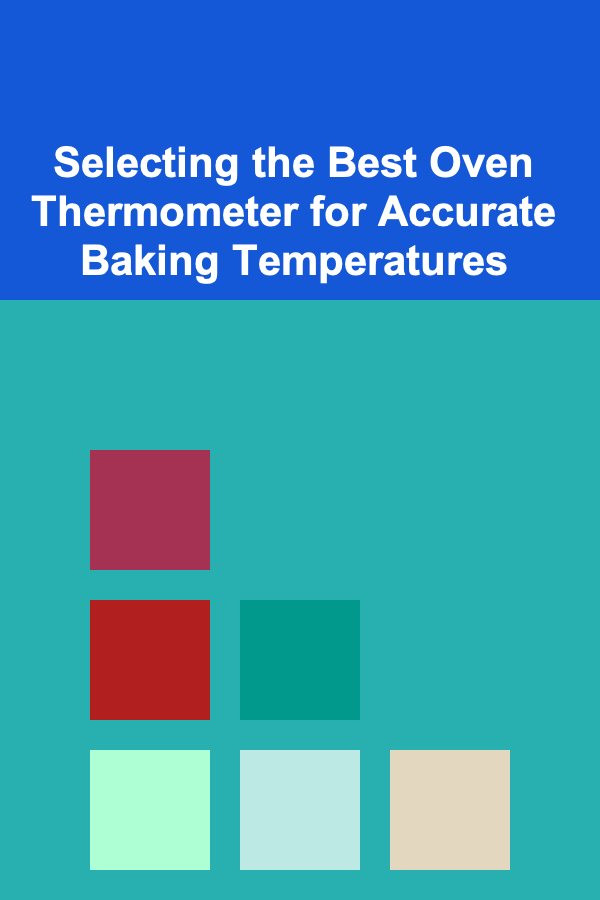
Selecting the Best Oven Thermometer for Accurate Baking Temperatures
ebook include PDF & Audio bundle (Micro Guide)
$12.99$11.99
Limited Time Offer! Order within the next:

Achieving baking perfection hinges on maintaining the correct oven temperature. While most ovens come equipped with internal thermostats, these are often inaccurate, leading to inconsistent results and frustrating baking experiences. An oven thermometer, a relatively inexpensive tool, becomes essential for ensuring accurate temperatures and, consequently, consistently successful baking. This article delves into the nuances of selecting the best oven thermometer, exploring the various types available, key features to consider, and best practices for usage, ultimately empowering you to elevate your baking game.
The Importance of Accurate Oven Temperatures
Before diving into the selection process, it's crucial to understand why accurate oven temperature is so vital. Baking is a science, and temperature plays a critical role in numerous chemical reactions that determine the final product's texture, color, and rise. Consider these points:
- Proper Rise and Texture: Many baked goods, especially those leavened with yeast or baking powder/soda, require a specific temperature range for optimal rise. Too low a temperature may result in a dense, flat product, while too high a temperature can cause the outside to burn before the inside is cooked.
- Color Development: The Maillard reaction, responsible for browning and developing rich flavors, is highly temperature-dependent. Inaccurate temperatures can lead to uneven browning or a lack of desirable caramelization.
- Consistent Results: Relying solely on your oven's thermostat can lead to unpredictable outcomes. One day, your cookies might spread too thin, and the next, they might be dry and crumbly. An accurate thermometer allows you to maintain consistency across batches.
- Predictable Baking Times: Recipes provide estimated baking times based on specific temperatures. If your oven runs hot or cold, you'll constantly struggle to adjust the baking time, often leading to guesswork and unsatisfactory results.
- Safety Considerations: Some recipes, particularly those involving meat, require specific internal temperatures to ensure food safety and prevent bacterial growth. An oven thermometer, used in conjunction with a meat thermometer, provides an extra layer of safety and peace of mind.
In essence, an oven thermometer provides confidence and control over the baking process, allowing you to execute recipes with greater precision and achieve consistently delicious results.
Types of Oven Thermometers
Several types of oven thermometers are available, each with its advantages and disadvantages. Understanding these differences is crucial for selecting the one that best suits your needs and baking style.
Bimetallic Coil Thermometers (Dial Thermometers)
These are the most common and often the least expensive type of oven thermometer. They work based on the principle of thermal expansion. A bimetallic coil, made of two different metals bonded together, expands and contracts at different rates when heated. This movement rotates a needle on a dial, indicating the temperature. Advantages:
- Affordable: Typically the cheapest option available.
- Easy to Read: The dial is generally large and easy to read at a glance.
- No Batteries Required: Operates mechanically, eliminating the need for batteries.
- Widely Available: Found in most kitchenware stores and online retailers.
Disadvantages:
- Accuracy Concerns: Bimetallic coil thermometers are generally less accurate than other types, particularly at lower temperatures. Accuracy can also drift over time.
- Slow Response Time: Takes longer to register temperature changes compared to digital thermometers.
- Calibration Issues: May require occasional calibration to maintain accuracy. Some models aren't calibratable.
- Parallax Error: Viewing the dial from an angle can lead to inaccurate readings due to parallax error.
Ideal for: Bakers on a budget or those who primarily bake at moderate temperatures (e.g., 350°F/175°C) and don't require pinpoint accuracy. Good as a backup thermometer or for quick checks.
Digital Oven Thermometers
Digital oven thermometers utilize electronic sensors to measure temperature and display the reading on a digital screen. They generally offer higher accuracy and faster response times compared to bimetallic coil thermometers. Advantages:
- High Accuracy: Generally more accurate than bimetallic coil thermometers, providing more reliable readings.
- Fast Response Time: Reacts quickly to temperature changes, allowing you to monitor fluctuations more effectively.
- Easy-to-Read Display: The digital display is clear and easy to read, even in low light.
- Features: Many digital thermometers include additional features such as alarms, timers, and programmable temperature settings.
Disadvantages:
- More Expensive: Generally more expensive than bimetallic coil thermometers.
- Battery Dependent: Requires batteries, which need to be replaced periodically.
- Durability: Some models may be less durable than bimetallic coil thermometers. Consider a model with a heat-resistant probe.
Digital oven thermometers come in two primary types:
- Probe Thermometers (Wired): These consist of a heat-resistant probe connected to a separate display unit via a heat-resistant wire. The probe is placed inside the oven, while the display unit sits outside, allowing you to monitor the temperature without opening the oven door.
- Digital Display Thermometers (Integrated): Similar in shape to dial thermometers, but with a digital display instead of a dial. These are placed directly inside the oven.
Ideal for: Serious bakers who demand accuracy and precision, particularly for delicate recipes or those requiring specific temperature ranges. The probe thermometer is especially useful for monitoring temperature changes during baking without opening the oven.
Infrared Thermometers (Laser Thermometers)
Infrared thermometers measure the surface temperature of an object without physical contact. They work by detecting the infrared radiation emitted by the object. While not typically used as primary oven thermometers, they can be helpful for spot-checking surface temperatures of baking sheets, pans, and even the oven walls. Advantages:
- Non-Contact Measurement: Allows you to measure temperature without touching the object.
- Fast Readings: Provides instant temperature readings.
- Versatile: Can be used for a variety of applications beyond baking, such as checking the temperature of cooking surfaces or food.
Disadvantages:
- Surface Temperature Only: Measures only the surface temperature, not the internal temperature. Not accurate for oven air temperature.
- Accuracy Can Vary: Accuracy can be affected by the emissivity of the object and the distance from the thermometer.
- Not Ideal for Oven Use: Not designed for continuous use inside a hot oven.
Ideal for: Checking the temperature of baking stones, pizza stones, or the surface of cookware. Not a replacement for a standard oven thermometer.
Key Features to Consider When Choosing an Oven Thermometer
Once you've decided on the type of oven thermometer you prefer, consider these key features to ensure you select the best model for your needs:
Accuracy and Calibration
Accuracy is paramount. Look for thermometers with a stated accuracy range, ideally within ±5°F (±3°C). Read reviews and compare specifications to gauge the thermometer's reliability. If possible, choose a thermometer that can be calibrated. Calibration allows you to adjust the thermometer to ensure it provides accurate readings, compensating for any drift that may occur over time. To calibrate a thermometer, you can use the ice water method (placing the thermometer in a mixture of ice and water; it should read 32°F/0°C) or the boiling water method (placing the thermometer in boiling water; it should read 212°F/100°C at sea level).
Temperature Range
Ensure the thermometer's temperature range is suitable for your baking needs. Most baking recipes require temperatures between 200°F (93°C) and 500°F (260°C). Choose a thermometer that covers this range comfortably. Some thermometers offer wider ranges, which can be useful for other cooking applications.
Durability and Heat Resistance
The thermometer must be able to withstand the high temperatures of an oven. Look for models made of durable materials like stainless steel. For probe thermometers, ensure the wire is heat-resistant and designed to withstand prolonged exposure to high temperatures. Read reviews to see if other users have reported any issues with the thermometer failing under high heat.
Readability
The thermometer should be easy to read, even from a distance. For bimetallic coil thermometers, look for a large dial with clear markings. For digital thermometers, choose a model with a large, backlit display. Consider the viewing angle if the thermometer will be placed inside the oven. Placement on the rack can make a difference in how easily you can read the thermometer without opening the oven door. The less you open the door, the more consistent the baking process will be.
Size and Placement
The size of the thermometer should be appropriate for your oven. A bulky thermometer can take up valuable space. Consider where you plan to place the thermometer inside the oven. Ideally, it should be placed in the center of the oven, away from the walls, heating elements, and oven door. This ensures an accurate reading of the overall oven temperature. Some thermometers have hooks or stands for easy placement.
Additional Features (Digital Thermometers)
Digital thermometers often come with additional features that can enhance your baking experience:
- Alarms: Allows you to set an alarm to alert you when the oven reaches a specific temperature.
- Timers: A built-in timer can be useful for tracking baking times.
- Programmable Temperature Settings: Allows you to program specific temperature settings for different recipes.
- Min/Max Temperature Recording: Records the minimum and maximum temperatures reached during baking, which can be helpful for troubleshooting.
- Wireless Connectivity: Some advanced models offer wireless connectivity, allowing you to monitor the oven temperature from your smartphone or tablet.
Price
Oven thermometers range in price from a few dollars to over $100. Consider your budget and the features you need. A higher price doesn't always guarantee better performance, so read reviews and compare specifications carefully. Prioritize accuracy, durability, and readability over unnecessary features.
Best Practices for Using an Oven Thermometer
Even the best oven thermometer is only effective if used correctly. Here are some best practices to follow:
Placement
Place the thermometer in the center of the oven, away from the walls, heating elements, and door. This will give you a more accurate reading of the overall oven temperature. If you are baking multiple items, place the thermometer near the item that is most sensitive to temperature changes.
Preheating
Allow the oven to preheat fully before taking a reading. Ovens often cycle on and off during preheating, so wait until the preheating cycle is complete and the oven has stabilized at the desired temperature.
Avoid Opening the Oven Door
Opening the oven door can cause significant temperature fluctuations. Minimize the number of times you open the door, especially during critical stages of baking. If you need to check on your baked goods, do so quickly and efficiently.
Regular Cleaning
Clean your oven thermometer regularly to remove any grease or food particles that may affect its accuracy. Follow the manufacturer's instructions for cleaning. Most stainless-steel thermometers can be cleaned with soap and water.
Calibration Checks
Periodically check the accuracy of your thermometer using the ice water or boiling water method. If the thermometer is not accurate, calibrate it according to the manufacturer's instructions. If it cannot be calibrated, consider replacing it.
Multiple Thermometers
For ovens with known hot or cold spots, consider using multiple thermometers placed in different locations to get a better understanding of the temperature distribution within the oven. This can help you adjust your baking practices to compensate for uneven heating.
Complementary Tools
An oven thermometer is a great start, but consider pairing it with other tools for maximum precision. A good quality timer can help prevent over- or under-baking, especially important when you're still learning your oven's quirks. A digital instant-read thermometer is invaluable for ensuring meat, poultry, or even bread doughs reach their target internal temperatures.
Troubleshooting Temperature Issues
Even with an accurate oven thermometer, you may still encounter temperature issues. Here are some common problems and possible solutions:
- Oven Runs Hot: If your oven consistently runs hotter than the set temperature, try lowering the set temperature by 25°F (14°C) and monitoring the thermometer. You may also need to have your oven professionally calibrated.
- Oven Runs Cold: If your oven consistently runs colder than the set temperature, try increasing the set temperature by 25°F (14°C) and monitoring the thermometer. Again, professional calibration might be needed.
- Uneven Baking: Uneven baking can be caused by hot or cold spots in the oven. Try rotating your baking pans halfway through baking. You may also need to adjust the placement of your oven racks or use multiple thermometers to identify and address hot or cold spots.
- Fluctuating Temperatures: Temperature fluctuations can be caused by a faulty oven thermostat. If you suspect a problem with your oven, contact a qualified appliance repair technician.
Conclusion
Selecting the best oven thermometer is an investment in your baking success. By understanding the different types of thermometers available, considering key features, and following best practices for usage, you can ensure accurate oven temperatures and consistently achieve delicious baked goods. Don't underestimate the power of this simple tool -- it can be the key to unlocking your full baking potential and transforming your culinary creations.
Reading More From Our Other Websites
- [Home Security 101] How to Safeguard Your Home with Smart Sensors and Alarms
- [Home Holiday Decoration 101] How to Achieve a Minimalist and Cozy Look with Scandinavian Holiday Decorations
- [Home Maintenance 101] How to Estimate Foundation Repair Costs: A Comprehensive Guide
- [Gardening 101] Best Plants for Your Indoor Garden: A Complete Guide
- [Home Rental Property 101] How to Maximize Your Investment by Offering Apartments with a Gym Amenity
- [Home Lighting 101] How to Install and Style Track Lighting: A Beginner's Guide to Versatile Home Illumination
- [Survival Kit 101] Top 5 Pre-Built Survival Kits: What You Need to Stay Prepared
- [Home Maintenance 101] How to Replace a Water Heater: A Step-by-Step Guide
- [Organization Tip 101] How to Pack Efficiently for Different Types of Travel
- [Personal Care Tips 101] How to Create the Best Hair Masks for Your Hair Type

Beginner's Guide to Creating a Simple Blog Post
Read More
How to Avoid Legal Pitfalls When Sourcing Products from Suppliers
Read More
How to Engage Kids in Charity and Donation Activities
Read More
How to Start a Small Business and Use It as an Investment Vehicle
Read More
How to Use Virtual Whiteboards for Collaborative Projects
Read More
How to Use Mindfulness for Creative Problem Solving
Read MoreOther Products

Beginner's Guide to Creating a Simple Blog Post
Read More
How to Avoid Legal Pitfalls When Sourcing Products from Suppliers
Read More
How to Engage Kids in Charity and Donation Activities
Read More
How to Start a Small Business and Use It as an Investment Vehicle
Read More
How to Use Virtual Whiteboards for Collaborative Projects
Read More